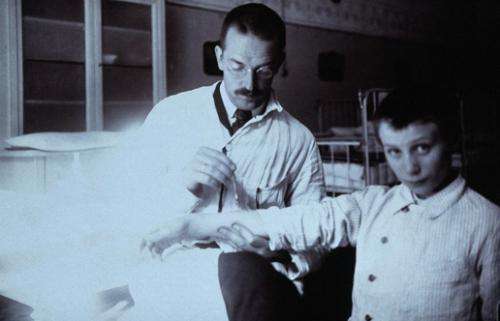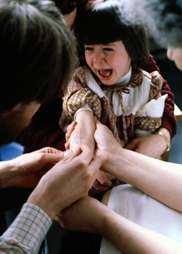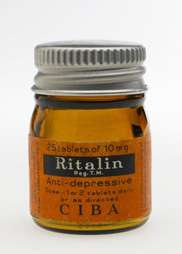Food allergy and hyperactivity: Histories of medical controversy

(Medical Xpress)—The journey of a new medical concept from radical theory to mainstream medicine is often dogged by controversy. Dr Matthew Smith argues that such controversies are fuelled by simplistic, inflexible thinking on all sides of the debate. He believes understanding the detailed history of previous medical controversies, notably food allergies and hyperactivity, could help us respond more constructively and resolve similar emerging issues more effectively in the future.
The Eskimos will welcome Lions, Roughriders, Tiger-cats and even Argonauts this season, but not peanuts. At Commonwealth Stadium, where the Edmonton Eskimos play their home games in the Canadian Football League, peanuts are the only snack that fans are specifically barred from bringing in with them. "We are allergy aware," it says on the Eskimos' website. "Please help us all be allergy aware."
Edmonton native and medical historian Dr Matthew Smith uses the ban in his hometown stadium to illustrate how food allergies have led to extreme reactions that would have been unimaginable just a few decades ago. "Prior to the 1990s," he says, "it was very difficult to find reference to peanut allergies in either medical or popular literature. Now they are almost an epidemic and the response has been - in many instances - draconian."

The dominant attitude to food allergies for most of the 20th century put them at the quackery end of allergy, a field that itself came pretty low in the medical establishment's pecking order. If you were concerned about your reaction to a particular food in the 1960s, for example, your doctor might very well have dismissed it as just a food fad. If you did get referred to a specialist, it was as likely to be to a psychiatrist as to an allergist.
Allergy has been fighting for respectability since 1906 when Professor Clemens von Pirquet, a Viennese doctor, coined the word. Before this, allergies were classed as 'idiosyncrasies', a term that cast allergic symptoms as medical oddities, beyond what the medical profession could be expected to understand, explain or treat. By contrast, von Pirquet defined 'allergy' as any form of altered biological reactivity, recognising that an allergic response was a function of the immune system that had been transformed from being healthy and protective to being harmful and pathological.
With non-food allergies, it is relatively straightforward to do skin tests to see which potential allergens cause the harmful reaction. This can then be followed by a regimen of desensitisation using small amounts of the allergen. This approach didn't work with food allergies, though: "There were too many false positives," says Smith. "And it was dangerous - people died in some early cases."
These days, most of us are aware (like the Edmonton Eskimos) of the life-threatening potential of allergies to peanuts and other foods such as shellfish and eggs. When allergic people eat these foods, their bodies produce an immediate anaphylactic response - a massive, inappropriate reaction of the immune system that can cause itching, swelling, restriction of the airways and spasms of the coronary arteries. In the face of such symptoms and the very real risk of death, there is no questioning the medical validity of these allergies, and there is now a lot of research into understanding, treating and preventing anaphylaxis.
The symptoms of non-anaphylactic food allergies are different. They take longer to appear - days, rather than hours - and include relatively non-specific symptoms, such as skin problems, asthma, migraines and behavioural disturbances. This makes it harder to identify the culprit. Diagnosis is usually confirmed through an elimination diet: the patient first cuts out all potentially allergenic foods. Then, different components of their diet are added back in until the symptoms re-emerge.
For some 20th-century critics of the allergy field, this approach to diagnosis was too much like hand-waving to be good science. "Medicine is often described as both an art and a science," Smith says. "This was too much on the arts side."
Indeed, although von Pirquet's definition of allergy was rooted in its immunological basis, for a long time his successors in the field continued to focus only on the particular 'idiosyncrasies' of each patient and not on the common underlying biology.
Perhaps this left a gap for the various homespun theories that have sprung up attempting to explain why allergy rates have increased so rapidly in recent years. Smith runs through a few of them: "There's the hygiene hypothesis - that we are living clean lives, not being exposed to allergens so not building up our immune systems properly. Related to that is the infections theory, which says the absence of childhood infections like mumps and measles leaves us vulnerable. There's a vaccine theory, suggesting that peanut oil in vaccines has made children hypersensitive. Then there are those who think it's linked to our diet or our mother's diet, because we eat a wider range of foods and so are just more likely to eat something that causes a reaction.
"There has been a lot of controversy over the years, and I think many people have become very entrenched in their views."
Controversy is what really attracts Smith in his choice of research. The full story of how food allergies became not just accepted but taken seriously enough to ban peanuts from football stadiums is still unfolding. However, they are not the only medical phenomena to have emerged from relative obscurity and, within a few decades, radically altered the way we think about food, behaviour and health.
Smith has just published a book called 'Hyperactive: The controversial history of ADHD', drawing on his previous research. Like allergy, ADHD (attention deficit hyperactivity disorder) went from controversial concept to medical orthodoxy in a matter of decades, but that is not the only point of connection between the two stories.
Hyperactive hype
Having introduced the word 'allergy' to the world, von Pirquet became professor of paediatrics at the University of Vienna's Children's Hospital in 1911 and held the post until his death in 1929. Doctors from all over the world would come to train with the great man. In his final year, a young American physician came to work for von Pirquet as a house officer before returning to the USA to specialise in allergy and children's health. His name was Dr Benjamin Feingold.

In 1974, retired from medicine but holding an emeritus position with an American healthcare consortium, Feingold published 'Why Your Child is Hyperactive', a book in which he recommended removing certain colours and flavours from the diets of children exhibiting hyperactive behaviour. His theory was that food chemicals triggered the disorder, and his solution was essentially the same kind of elimination diet that would be used to identify and avoid food allergies. The 'Feingold diet' quickly became popular with many American parents who saw it as a more natural way to treat hyperactivity than Ritalin, a stimulant drug that was by then widely prescribed in the USA.
Doctors were less enamoured of the dietary approach, and arguments raged over whether it was an appropriate alternative to drugs like Ritalin. Feingold was not helped by the fact that numerous scientific studies failed to support his theory. Smith says this is not surprising: in a 2011 book about the Feingold diet, he revealed that many of the studies were indirectly funded by the food industry. When positive effects were observed, there always seemed to be a reason for deeming those findings inconclusive.
But independently funded research drew a blank as well. "The most objective studies gave the most equivocal answers," says Smith. "The availability of scientific evidence is dependent on what is scientifically possible. You can't really do randomised controlled trials in food allergies and hyperactivity - how do you control for food additives?
"Researchers tried making special cookies with or without additives, but if you used them in a trial, there'd be the significant problem of the amount of sugar you were giving the children. Plus the kids couldn't physically eat enough cookies to get the relevant doses!"
Observational studies comparing hyperactive children on the Feingold diet to those not were also challenging. Although Feingold had spelled out the requirements of the diet in rigorous terms in his books (and it was this strict version of the diet that was generally tested in trials), Smith has spoken to parents who tried it and discovered that many adapted it to suit their children.
"Parents used a flexible mix of approaches until they found a balance that worked for them," he explains. "They were not passive in the way they adopted the diet, and neither were their children.
"I heard of one young man who deliberately ate great handfuls of candy before playing football games precisely because he knew it would give him the necessary aggression and courage to perform well on the field."
Smith admits to slightly taking sides in his discussion of the rise of hyperactivity as a disorder and the various approaches to treating it. "The weight has been so much on the neurological and genetic side," he says, "but there are so many other factors that need to be taken into account.
"My aim is to get to the root of why we see these behaviours as problematic at all."

Accentuate the positives
He describes an advert from the 1960s. It shows a sad-looking woman next to a mountain of unpeeled potatoes. It's a before and after set-up. In the 'after' picture, the woman looks no happier, but the potatoes are all peeled. The difference? Ritalin.
"In the 1950s," he explains, "Ritalin was used as a stimulant for chronically depressed psychiatric patients. It was a treatment for something called 'chronic housewife fatigue syndrome'. But it didn't do all that well as a pep pill so Ciba, the company that manufactured it, was looking for another market."
They found one in Rhode Island. There was a history of using amphetamines to treat hyperactivity, although in 1957 it was essentially limited to one psychiatric home for children in the smallest of the United States. Doctors at this institution also defined hyperactivity in such a broad way that it was applicable to lots of children. Those who were admitted to the hospital with a diagnosis based on this definition were treated with stimulants, including Ritalin.
Ciba leapt on this: as well as marketing the drug to doctors, they marketed the disorder to the public, using the broad definition of hyperactivity. "They made before and after films, which they showed at PTA [parent-teacher association] meetings in schools," Smith says. "They got their wrists slapped for doing that - they were only supposed to show direct marketing to physicians - but by then the parents knew all about it and demand grew.
"Parents were happy to put their kids on the drug. It didn't prevent or cure the disorder, but at least it calmed the kids down."
Why would American parents be happy to put their children on powerful stimulants for a disorder that wouldn't have been treated as an illness ten years earlier? Smith says we have to look at the wider context.
In late 1957, while children in Rhode Island were being admitted to hospital for being hyperactive, Sputnik 1 was somewhere above them, orbiting the Earth. The Soviets' achievement lit a rocket, you might say, under the American educational establishment. Schools came under enormous pressure to produce young people capable of competing with the Soviet system. Improving education became a central tenet of President John F Kennedy's big idea in office, the 'New Frontier'.
JFK's successor, President Lyndon B Johnson, expanded the government's role in education as part of his 'Great Society' legislative programme to reduce poverty in the USA. Schools introduced student counsellors in an attempt to help improve achievement for all children and raise standards across the whole educational system.
Hyperactivity was no longer just disruptive in the classroom; it was a limiting factor in a child's potential future success and, therefore, the country's potential future success. It was practically un-American.
Of course, the modern phenomenon of hyperactivity is not restricted to the USA. If he were growing up in Canada today, Smith believes he might well be labelled as hyperactive too. This, in part, fuelled his initial interest in the topic and his desire to challenge the negative stereotype of the hyperactive or inattentive child.
"'Hyperactive' behaviour can equally be cast in a positive light, and would have been at any time before the rise of ADHD over the last 50 years," he says. "There have been attempts to retrofit hyperactivity to characters from history or even from literature, notably Tom Sawyer and Huckleberry Finn, but in a different environment, these characteristics can be viewed entirely positively.
"Defiance in the face of authority could be interpreted as courage, like the kid who ate candy before a football game. An 'inattentive' child might equally be called 'creative', and instead of 'hyperactive', we could say 'energetic'."
The choice of words is as significant now as when von Pirquet first defined 'allergy'. But there are many other striking similarities between the histories of food allergies and hyperactivity, according to Smith: "Both involved a medical profession in a battle for legitimacy, where children were at risk and their parents were highly motivated to do their own research, although the majority accepted and adopted the orthodox view.
"In each case, the debate was framed as a battle: two sides fighting for the truth. The debates became extremely polarised as they evolved, with very few people sympathetic to both sides. When you look at the extreme language that was used by doctors and researchers arguing their positions in contemporary medical journals, you can only wonder at what their first drafts must have sounded like!"
Polemics play well in the media and there is always a temptation to reduce issues to one cause and one solution. However, in 'Hyperactive', Smith writes that "all medical knowledge is a complex construction, a conglomerate consisting of cultural, social, political, technological and scientific constituents that is forever changing, and not always for the better."
By laying out the full history of how new medical phenomena emerge and, crucially, how they change over time, Smith hopes to encourage more sophisticated, pluralistic approaches to controversial disorders and diseases. "With the insights we get from looking at the way past medical controversies have unfolded," he concludes, "I think we will be more likely to reach informed resolutions in the future."
More information:
- Smith M (2012) Hyperactive: The controversial history of ADHD. Reaktion Books: London.
- Smith M (2011) An Alternative History of Hyperactivity: Food additives and the Feingold diet. Rutgers University Press: New Brunswick, USA.
- Edmonton Eskimos website. Fan Guide esks.com/page/fan_guide [accessed 24 August 2012].
- Feingold Association of the United States. Dr Feingold's biography www.feingold.org/bio.html [accessed 24 August 2012].















